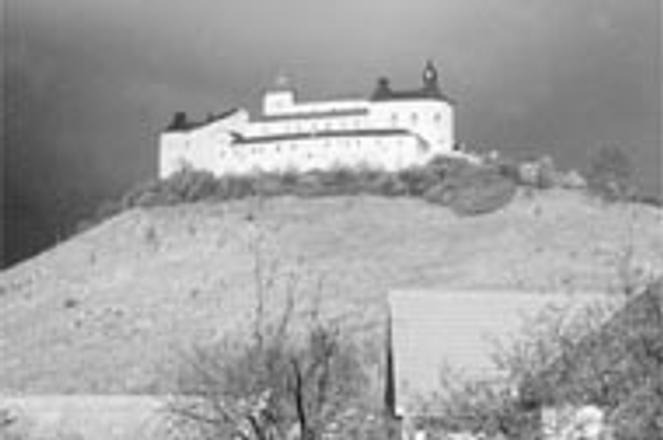A storm over Krasna Hôrka darkens the skies in south-eastern Slovakia's fascinating Rožňava region.Matthew Evans
Slovakia's southern lowlands stretch due east from Bratislava, gradually giving way to gently rolling hills bristling with beech, birch and pine. In the same way, the quiet villages that dot the landscape near Bratislava make room for the castles, palaces and caves of Slovakia's eastern reaches.
Much of the region's charm comes from its Slovak-Hungarian heritage. Until 1918, the southern region from Bratislava past Košicewas part of Hungary. The Hungarian nobles who ruled the district tried to assimilate the Slovak peasants through a process known as "Magyarization".
Looking around today, one would never suspect that places like Šahy, Fiľakovo and Hurbanovo had such a stormy history. Hungarian is still the dominant language spoken on the streets. Many older locals in the south speak a more broken Slovak than some foreign visitors. Kiosk signs and restaurant menus all feature both languages. A white-on-blue Hungarian nameplate hangs below every street sign.
Rožňava, three hours east by car from Bratislava and just one hour from Košice, offers a magnificently colourful base for exploring this cultural melting pot. The old mining town contains two of Slovakia's finest examples of the life of the old Hungarian nobility - Betliar Chateau and Krásna Hôrka Castle.
Krásna Hôrka is a fully reconstructed and beautifully maintained fortress. The Mariássy family built it in the early 13th century high on a limestone hill above the village of Krásnohorské Podhradie, at a crossroads between the northern Spiš region and Košice. The castle changed hands repeatedly over the years until being taken over in the 16th century by the Andrássys, a famous Hungarian noble dynasty. Thanks to Dionýz and Františka Andrássy, Krásnohorské Podhradie boasts not only a massive castle but also a museum and a mausoleum. The Andrássys began to build the castle museum in 1867 and opened it to the public in 1906.
Today's one-hour castle tour takes visitors through 31 rooms of non-stop wonder. Highlights include the former counterfeit money and metal workshop houses, fearsome battle axes, intricate metal hinges and spikes to throw on the ground to thwart advancing enemy cavalry. Nearby, in the Gothic Palace, 17th century war drums and cannons rest one floor beneath the "beating and cutting weapons" display and the chilling torture chamber. Hungarian and Turkish soldiers' uniforms - complete with pointed slippers, turquoise-encrusted sword handles and sheaths as well as fur hats with plumes - also grace the second floor. The Northwest tower houses Františka Andrássy's personal belongings, including exquisite pencil drawings of people, landscapes and animals.
The tour reaches an eerie climax in the magnificent chapel. There, beneath the arched and frescoed ceiling, lie the mummified remains of Zsófia Seredy behind a glass sarcophagus. She is decked out in black lace and wears a ghastly grimace on her pasty white face. Her hand is frozen in mid-air, as if to summon a lover.
One legend claims that she died of humiliation after discovering her husband's affair with the White Lady of Levoča. When her children plotted to murder their father in retaliation, the corpse raised its hand in protest. The official story, however, is that both hands were propped up by a bible placed on her chest during burial. Her left hand was accidentally broken and the bible removed when she was transported here from the village church.
The Andrássy Gallery, below the castle, displays 18th and 19th century portraits collected by Dionýz Andrássy, the last private owner of the castle and a passionate art collector. Dionýz also built the mausoleum, one kilometer down the road to Košice, for his wife after she died in 1903. The white domed structure is considered one of the finest examples of Art Nouveau in Slovakia.
Betliar Chateau, just a few kilometers from Rožňava in the opposite direction, offers a more civilized look at the fun-loving nobility. The Buddha figure, which sits out front in the gorgeous English gardens, offers a glimpse of the Andrássy family's fascination with the exotic. Plenty of other examples await inside: the replica cave with stuffed bears and other wild animals, a room full of samurai warriors, Chinese, Turkish, and African warrior outfits, an elephant tusk and even a 4,000 year-old Egyptian mummy from the Giza pyramid.
The bulk of the collections consist mainly of household furniture, pictures and trinkets. One highlight is the historic 18th century library, which houses over 18,000 volumes. At this time of the year, the exhibit is open daily from 8:00 to 15:30.
Once you've had your fill of opulent noble life, take a trip to the underworld of the Slovak Karst at Domica or Gombasecká cave.


